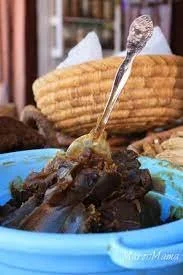The Versatile Beauty of Moroccan Black Soap
Some of the simplest, most elegant (and effective) skincare comes from Morocco, and one of my favorites is Savon Beldi.
If you’ve ever wondered the souk, you have seen piles of herbs, freshly distilled floral waters, chunks of clay, and basins of goopy soap paste. The soap paste is sometimes called Savon Noir Beldi or Moroccan Black Soap.
Savon Beldi in the souk
The soap paste is distinctly different from other soaps because it is neither a bar nor liquid, and it is uniquely Moroccan. The origin of this particular soap-making process is from Syria. It seems only Morocco embraces the Savon Noir as ‘beldi’.
‘Beldi’ means ‘of the country’ -authentic, traditional. Beldi applies to certain rugs, blown glassware, textiles and this Moroccan Black Soap.
In addition to learning the origins of the process, I learned that long-ago people used soap for household cleaning, like textiles and rugs, but not for bathing. In early bath houses, oil was used to cleanse the body. And water was used to remove the oils. Historically it took awhile for soap to catch on as a means for cleaning the body.
All of us are keenly aware of germs these days and have amped up our handwashing. However, many products called soap are detergents that are harsh on skin. Real soap is made via chemical reaction with dense fats and a very alkali solution. It’s possible to make the formula complicated, but the beauty of the Moroccan Black Soap is that it has four very pure ingredients: olive oil, the fruit of the olive, water and potash.
There are some sciency reasons why this simple formula is so magical.
For one, the soap becomes creamy, rather than frothy when it is in contact with steam and water. When applied to damp skin, and left as a mask, it gently exfoliates, allowing the skin to receive creams and lotions more effectively. Skin responds well to small disruptions in the protective acid mantle, which the soap provides. Additionally, the savon beldi contains trace minerals that destroy toxins, oxygenate cells and act as a catalyst to improve collagen production.
When you purchase a lot of commercial soaps you’re paying for a lot of added water AND additional packaging, preservatives and janky chemicals. One of my favorite things about a bar soap, or this Savon Beldi, is that YOU add the amount of water you need and there isn’t any extraneous packaging waste.
You can use the soap on your hair, face and body. It is still used for household chores as well - I have many friends who still use it on rugs and textiles.
If you’ve ever purchased the paste and brought it home, you may find that it becomes pretty soupy in the container. Storing the paste with the lid resting on the top, or without the lid at all, may prevent this ‘liquefiction’. I personally keep an open jar at the kitchen sink for hand washing, and I’ve been known to pour the soupy soap into a bottle with a pump and use it this way. I haven’t yet unraveled the mystery of WHY this happens. But I have successfully made the soap following two recipes which I’ll share here.
There is another connection between the hammam and the Moroccan black soap: tadelakt. The waterproofing of lime-plaster work done with Savon Beldi. Examples of this can be found throughout Morocco.
For those of you who are DIYers, it is pretty easy to make the soap! I have used several recipes and have perfected one for creating the soap I sell. If you want to make your own batch, I recommend this video


